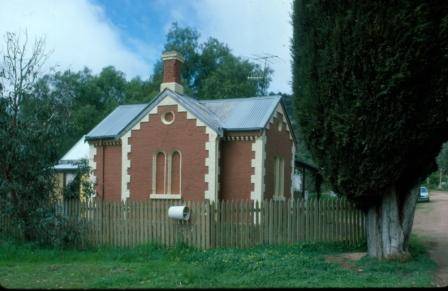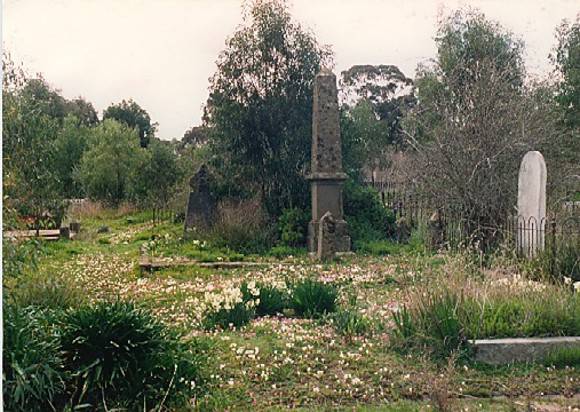| Back to search results » | Back to search page » |
|
Maldon Cemetery
LocationJunction of Maldon, Nuggetty & Back Cemetery Roads,, MALDON VIC 3463 - Property No B6818
File NumberB6818LevelState |
|
Statement of Significance
Maldon Cemetery, laid out to a design of trustee William Falla Smith in 1861, with the 1872 section designed by W H Waller and additional design by James V Walshe (undated), and in continual use since 1861, is of state significance for the following reasons:
-its importance in the course of Australia's cultural history as a substantially intact example of a mid nineteenth century goldfields cemetery demonstrating unusual ideas about layout and planting of the period. *It exhibits unusual cultural features associated with the development of mid nineteenth century goldfields cemeteries, such as the irregular arrangement of straight and curved paths.
-its possession of uncommon aspects of Australia's cultural history as a mid nineteenth century goldfields cemetery.
*Its importance in demonstrating a distinctive way of life, custom, and design no longer practised and in danger of being lost. It is of exceptional interest as most mid nineteenth century cemeteries no longer demonstrate their characteristic design as twentieth century overcrowding and neglect have generally resulted in the loss of earlier schemes. Maldon Cemetery developed in the twentieth century in a manner which both respects the early section of the site and expresses contemporary ideas.
*For its collection of trees and plants, including ground cover plantings of Oxalis purpurea, (rose, purple and white color forms), Narcissus cultivars, Belladonna Lily (Amaryllis belladona), Oxalis hirta, Cuban Lily (Scilla peruviana, blue and white forms), Blue Agapanthus (Agapathus praecox subsp.orientalis), Arum Lily (Zantedeschia aethiopica), Freesia leichtlinii and Periwinkle (Vinca major). Other trees and plants including Italian Cupress (Cupressus sempervirens,)Silky Oak (Grevillea robusta), two Pepper Trees (Schinus molle var. areira), Oleander (Nerium oleander), Winter Honeysuckle (Lonicera fragrantissima), Willow-leaf Hakea (Hakea salicifolia), Cape Homeysuckle *Tecomeria capensis), Jasminum polyanthum, Century Plant (Agave americanana), Tasmanian Blue Gum (Eucalyptus globulus subsp. globulus stand), Grey Box (Eucalyptus microcarpa), Lightwood (Acacia implexa), Kangaroo Grass (Themeda triandra), seven Montery Cypress specimens (Cupressus macrocarpa) and a rare Tree Anemone ( Carpentaria claifornica) near the rotunda -its potential to yield information that will contribute to an understanding of Australia's cultural history. * Its importance for information contributing to a wider understanding of Australian history, by virtue of its use as a research and reference site.
*Its importance for information contributing to a wider understanding of the history of human occupation of Australia. For example by providing information about the patterns of deaths in the colonial city by age, religion and family; and sometimes giving causes, occupations and other infortmation. By illustrating the importance of homelands in epitaphs and also by demonstrating the range of technical and craft skills and materials available.
*Its strong links with Maldon which became one of the richest goldfields in the world, second only to Bendigo in Victoria in regard to the significance of quartz mining.
*Its strong links with the Chinese miners and miners experienced in underground mining, like the Welsh coal miners and Cornish tin miners.
*For its value as a historical record, a collection of individual memorials, its continuity and security, for the manner in which it inspires a respect for the dead, as a social document, and for its role in educaton and recreation.
-its importance in demonstrating unusual characteristics of : (1) A class of Australia's cultural places, being mid nineteenth century goldfields cemeteries.
*Its importance in demonstrating unusual attributes which are not characteristic of the class. These are: the unusual road and path layout with an oval section of the plan, the lack of separate denominational compartments, and a picturesque layout with irrugular curving and straight roads.
*Its importance in demonstrating the principal characteristics of the range of human activities in the Australian environment (including way of life, custom, process, land use, function, design or technique). It demonstrates goldfields life, including the role of the Chinese, death in mining disasters and infant mortality. -its importance in exhibiting Victorian aesthetic characteristics valued by the colonial community.
* Its importance to the communtiy for aesthetic characteristics held in high esteem is demonstrated in the value of the cemetery as a public park, the vistas and views within the cemetery, the rotunda, and also in that twentieth century development respected the earlier design.
*The cemetery has a significant and impressive collection of trees, shrubs, bulbs and ground cover species and in late August the cemetery is one of the most colorful landscapes in Victoria. It also has the impressive backdrop of Mt. Nuggetty with its granite outcropping and is set in partucularly picturesuqe surroundings.
-its importance in demonstrating a high degree of creative or technical achievement of the Victorian period. *importance for technical, creative, design or artistic excellence, innovation or achievement, including the substantial intact c1900 rotunda, the rebuilt sexton's residence, the Chinese funery oven and the cemetery's collection of memorials, tombstones and other funerary art.
-its strong or special associations with a particular community or cultural group for social, cultural or spiritual reasons.
*Its importance as a place highly valued by a community for reasons of religious, spiritual, symbolic, cultural, educational and social associations. Maldon Cemetery has special associations for the local communtiy because of its continual use since 1858 but is also of special importance to Chinese descendants.
-its special association with the life or works of a person, or group of persons, of importance in Australia's natural or cultural history,
*Its importance for close associations with Victoria's rich goldfields. The cemetery retains excellent evidence of Maldon's gold history, from the original rush of 1854, through a depression and subsequent quartz-crushing boom in 1859/60, followed by a twenty year period of settled prosperity.
Classified: 04/08/1997
Group
Cemeteries and Burial Sites
Category
Cemetery/Graveyard/Burial Ground





